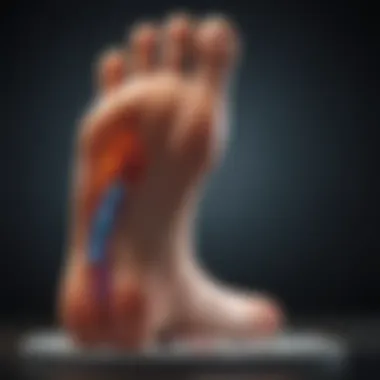Understanding Neuropathic Diabetic Foot: Impacts and Management


Intro
Neuropathic diabetic foot is a significant complication faced by many patients with diabetes mellitus. This condition arises when nerve damage occurs due to prolonged high blood sugar levels. The consequences are severe, leading to a loss of sensation in the feet, making individuals susceptible to injuries, infections, and ultimately, amputations. Understanding the pathophysiology of neuropathic changes and the risks associated with this condition is crucial for both patients and healthcare providers.
This article aims to shed light on various aspects of neuropathic diabetic foot, including its underlying mechanisms, clinical presentations, risk factors, and management strategies. By synthesizing recent research findings and established clinical guidelines, this article targets students, researchers, educators, and healthcare professionals who seek a deeper understanding of the topic.
Research Highlights
Key Findings
Recent studies have identified several key findings regarding neuropathic diabetic foot. These findings include:
- Increased Incidence: Neuropathic foot ulcers are a common outcome, affecting 15-25% of individuals with diabetes.
- Nerve Damage Mechanisms: High glucose levels lead to various biochemical changes, contributing to nerve damage. These include oxidative stress and inflammation.
- Risk Factors: Factors such as poor glycemic control, neuropathy, foot deformities, and a history of foot ulcers significantly elevate the risk of developing neuropathic diabetic foot.
- Early Detection: Regular foot examinations allow for early detection of neuropathic changes, which is vital for preventing severe outcomes.
Implications and Applications
The implications of these findings are profound. Understanding the mechanisms behind neuropathic diabetic foot paves the way for innovative management approaches. Education about self-care and foot hygiene can significantly reduce the risk of ulcers. Regular screening for neuropathy in diabetic patients can lead to timely interventions, potentially saving limbs and improving quality of life.
"Early detection and management of neuropathic diabetic foot can prevent complications and improve outcomes for diabetic patients."
Methodology Overview
Research Design
The body of research on neuropathic diabetic foot often employs a mixed-methods approach. Both qualitative and quantitative studies are utilized. This allows for a comprehensive view of the experiences of individuals with diabetic foot complications.
Experimental Procedures
In clinical settings, common procedures include neurological assessments to evaluate nerve function. Researchers frequently use monofilament tests and tuning forks to assess sensory perception in the feet. Additionally, observational studies allow researchers to monitor how various management strategies impact patient outcomes, shedding light on what approaches are most effective.
By focusing on these elements, the article will provide a holistic perspective on neuropathic diabetic foot, emphasizing the importance of education, early detection, and appropriate interventions.
Preamble to Neuropathic Diabetic Foot
The topic of neuropathic diabetic foot is crucial because it highlights the specific complications that arise from diabetes mellitus. Neuropathic complications can directly affect the quality of life for many individuals living with diabetes. Understanding these issues is essential for healthcare providers, patients, and caregivers. Without proper awareness and management, neuropathic diabetic foot can lead to significant morbidity, including infections and even amputations.
Neuropathy, or nerve damage, is often a silent complication of diabetes. As the condition progresses, the symptoms may appear slowly, leading to a lack of recognition until significant damage has occurred. This gradual onset emphasizes the importance of early recognition and consistent monitoring.
The importance of this section resides in its ability to inform readers about the potential risks associated with diabetic neuropathy. Key points include the need for patient education, recognizing the signs and symptoms, and understanding the importance of foot care. Additionally, early interventions can greatly reduce serious outcomes.
Neuropathic diabetic foot is not only a clinical concern but also a socioeconomic one. The costs associated with treatment and complications can severely impact healthcare systems. Therefore, increasing awareness can contribute to improved outcomes and reduced burden on health resources.
In summary, the introduction to neuropathic diabetic foot sets the stage for the rest of the article. It underscores the complexities and challenges that come with diabetes management. Given the widespread nature of diabetes, this knowledge becomes even more vital.
Overview of Diabetes Mellitus
Diabetes mellitus includes a group of metabolic disorders characterized by persistent hyperglycemia. This condition disrupts normal glucose metabolism, resulting in various complications, including neuropathic diabetic foot. Understanding diabetes is crucial for grasping peripheral nerve involvement and its associated risks. The multifaceted nature of diabetes requires thorough knowledge of its types and consequences.
Types of Diabetes
Type One Diabetes
Type One Diabetes is an autoimmune condition where the immune system attacks insulin-producing beta cells in the pancreas. This leads to absolute insulin deficiency. The key characteristic of Type One Diabetes is its early onset, often diagnosed in childhood or adolescence. Understanding this type is beneficial as it highlights the physiological reliance on insulin therapy right from diagnosis. A unique feature is the potential for multiple complications occurring early in life, which necessitates lifelong management strategies.
Type Two Diabetes
Type Two Diabetes is more prevalent and typically arises when the body develops insulin resistance or fails to produce sufficient insulin. The key characteristic is its gradual onset, often associated with obesity and lifestyle choices. This type is important as it accounts for the vast majority of diabetes cases globally. A distinctive factor of Type Two Diabetes is the role of lifestyle modifications in management, making it feasible for individuals to improve their condition through behavior changes.
Gestational Diabetes
Gestational Diabetes occurs during pregnancy when the body cannot produce enough insulin. The key characteristic here is its temporary nature, as symptoms often resolve after childbirth. However, it serves as a significant risk factor for developing Type Two Diabetes later in life. Understanding this type sheds light on maternal health and long-term implications. Moreover, the unique aspect of Gestational Diabetes is its implications for child health, reinforcing the need for careful monitoring during and after pregnancy.
Pathophysiology of Diabetic Neuropathy
Metabolic Disturbances
Metabolic disturbances in diabetes lead to altered cellular processes, impacting nerve health. A key characteristic of these disturbances includes changes in glucose and lipid metabolism. This section is beneficial for understanding the mechanistic pathways that underlie neuropathy. The unique feature is how prolonged hyperglycemia results in neurological damage, ultimately contributing to the pathology of diabetic foot complications.
Microvascular Complications
Microvascular complications are common in diabetes, affecting small blood vessels. Key characteristics include alterations in blood flow and oxygen delivery to peripheral nerves. This aspect is important as it is directly linked to the development of neuropathic diabetic foot. A notable feature of microvascular complications is their insidious nature, often leading to severe outcomes before patients even recognize symptoms.
Oxidative Stress
Oxidative stress occurs when there is an imbalance between free radicals and antioxidants in the body. A key characteristic is its role in neuronal injury. By understanding oxidative stress in the context of diabetes, we can appreciate how it perpetuates sensory and motor nerve damage. A unique aspect of oxidative stress is its contribution to inflammation, further complicating the clinical picture of neuropathy in diabetes.
"Understanding the pathophysiology of diabetes mellitus is critical for effective management of its complications, including neuropathic diabetic foot."


Defining Neuropathic Diabetic Foot
Understanding Neuropathy
Neuropathy, specifically in the context of diabetes, represents a progressive issue. Damage occurs primarily due to prolonged high blood sugar levels. This damage affects sensory nerves, motor nerves, and autonomic nerves.
Sensory neuropathy causes a loss of feeling in the feet. The inability to feel pain can lead to unnoticed injuries. Motor neuropathy may weaken muscles in the foot, leading to issues like deformities and difficulty walking. Autonomic neuropathy affects the regulation of sweat glands, contributing to foot dryness and increasing risk of skin breakdown.
Foot Complications Associated with Diabetes
Complications are frequent in diabetic patients, particularly regarding the foot. Two significant concerns are ulceration and Charcot foot.
Ulceration
Ulceration is a critical concern for patients with neuropathic diabetic foot. It can occur when there is a prolonged pressure on a specific area of the foot. Because that area loses sensation, patients often do not realize when they have a wound. Ulcers can lead to severe infections.
A key characteristic is its potential for rapid progression. Once an ulcer forms, it can worsen quickly if not addressed. This makes awareness and preventive strategies particularly important. Treating ulcers typically involves regular cleaning and dressings. Awareness of ulcerations can significantly impact patient outcomes by preventing major complications such as amputations.
Charcot Foot
Charcot foot is another serious condition linked with diabetic neuropathy. It occurs when nerves that control foot stability are damaged. As a result, the bones can weaken, leading to fractures and deformities. Some key characteristics include redness, swelling, and deformity of the foot.
Charcot foot can be deceptive since its symptoms may not be painful initially. However, the long-term implications can severely affect mobility and quality of life. It can lead to significant complications, including further deformities and issues with shoe-fitting. Treatment needs early diagnosis and intervention to prevent significant damage.
"Preventive measures, education, and awareness of neuropathic conditions can prevent serious complications in diabetic patients."
In summary, defining neuropathic diabetic foot and its associated conditions is fundamental for understanding diabetes management. Recognizing issues like ulceration and Charcot foot can improve patient care and ultimately reduce the risk of severe outcomes.
Clinical Presentation and Symptoms
Understanding the clinical presentation and symptoms of neuropathic diabetic foot is essential for effective patient management and early intervention. These symptoms can significantly impact the quality of life for individuals with diabetes. Recognizing these signs allows healthcare providers to implement timely treatment strategies, which can prevent complications such as ulcers and infections. In this section, we will explore the various symptoms associated with neuropathy in the context of diabetic foot.
Sensory Symptoms
Sensory symptoms are notable indicators of neuropathic diabetic foot. Patients often experience altered sensations, which can range from numbness to tingling and even pain in the feet. The inability to feel pain correctly can result in injuries going unnoticed. This lack of awareness can lead to significant complications over time.
Some common sensory symptoms include:
- Numbness: This can start at the toes and move upward, causing a gradual loss of feeling.
- Tingling: Patients may report a pins and needles sensation, which can be uncomfortable.
- Burning Pain: Some feel a burning sensation in the feet, which can be distressing.
- Increased Sensitivity: Even light touch can become painful in certain areas.
It is crucial for patients to communicate these symptoms during clinical evaluations. Early recognition aids in planning therapeutic interventions to address and alleviate these sensations.
Motor Symptoms
Motor symptoms are another critical aspect to consider in neuropathic diabetic foot. Dysfunction in the motor nerves can lead to muscle weakness and atrophy, resulting in deformities or difficulty in movement. This aspect can impact mobility and the overall functionality of the patient.
Prominent motor symptoms include:
- Weakness in Foot Muscles: This makes it hard to lift the foot properly.
- Foot Drop: A condition where raising the front part of the foot is difficult, leading to dragging of the foot while walking.
- Muscle Atrophy: Continuous weakness can result in the shrinking of foot muscles, leading to changes in foot structure.
These motor symptoms can significantly affect daily activities, making proper assessment and rehabilitation vital in enhancing mobility and maintaining independence.
Autonomic Symptoms
Autonomic symptoms refer to the dysfunction of the involuntary nervous system, which impacts the regulation of bodily functions. In diabetic foot patients, these symptoms can often lead to further complications, affecting skin and vascular health.
Key autonomic symptoms consist of:
- Changes in Skin Temperature: The feet may feel cooler or warmer than normal due to disrupted blood flow.
- Altered Sweating Patterns: Patients may either sweat excessively or not enough, affecting skin hydration.
- Dry Skin: This can result from reduced blood supply and can increase the risk of skin integrity issues.
It is critical to recognize that the presence of these symptoms can indicate worsening conditions, and integrated management approaches are necessary for preserving foot health.
Diagnosis of Neuropathic Diabetic Foot
The diagnosis of neuropathic diabetic foot represents a critical step in managing this serious complication of diabetes mellitus. It is essential for identifying individuals at risk and implementing timely interventions that can significantly affect outcomes. Early diagnosis can aid in preventing severe complications like ulcerations and infections, which may lead to amputations. This section aims to detail the various methods used for diagnosis, focusing on both clinical assessments and advanced diagnostic tools.
Clinical Assessment
A thorough clinical assessment is the foundation of diagnosing neuropathic diabetic foot. Physicians usually begin with a comprehensive patient history, which will include details of diabetes management, duration, and any previous foot complications. A physical examination follows, focusing on both sensory and motor functions of the feet.
During the physical exam, practitioners look for indicators such as skin integrity, temperature differences, and any visible abnormalities. The presence of deformities, calluses, or signs of infection can provide essential insights into the patient's overall foot health. Using tools like a tuning fork or monofilament can help gauge sensory responses, which are vital in determining the level of neuropathy present.
Diagnostic Tools
Monofilament Testing
Monofilament testing is a widely accepted method for assessing the sensory function of the feet in diabetic patients. This test uses a thin, flexible filament that applies a specific pressure on the skin. When a patient is unable to feel the filament, it indicates a loss of protective sensation, which is a key symptom of diabetic neuropathy.


Its main advantage lies in its simplicity and quick execution. The test can be performed in various settings without the need for specialized equipment. However, it requires proper training to ensure accurate application. Its primary drawback is that it might miss early nerve damage, thus leading to false assurances in some patients.
Tuning Forks
The use of tuning forks in diagnostics focuses on evaluating vibration perception. Placed on bony prominences of the toes, a tuning fork produces a specific frequency that tests the patient’s ability to sense vibrations. This method is valuable because loss of vibration sense correlates highly with neuropathy severity.
One of its key characteristics is the immediate feedback it provides. Healthcare professionals can assess both sensory and motor function with a simple device. However, like the monofilament test, it can be subjective and depend on the practitioner’s technique.
Vibration Perception Testing
Vibration perception testing evaluates the ability to sense vibrating stimuli. Devices used can measure thresholds of vibration, offering detailed insights into sensory nerve function. This objective data can be extremely helpful for categorizing the severity of neuropathy and establishing a baseline for future comparisons.
Its reliability makes it a popular option for clinicians. The key feature is its detailed quantification of nerve function, allowing for more tailored management plans. However, drawbacks include the requirement for more sophisticated equipment and the need for trained personnel to perform measurements effectively.
Imaging Techniques
X-rays
X-rays are frequently used to assess structural abnormalities in the foot. By providing clear images of bones, they can help in identifying deformities or fractures, which can be crucial for diagnosing complications associated with neuropathic diabetic foot.
X-rays are readily available and do not involve high costs. Their immediate results can guide outpatient treatment. However, they do not visualize soft tissue well, leaving a gap in the assessment of conditions like infections and ulcers.
MRI
Magnetic Resonance Imaging (MRI) plays a crucial role in providing more detailed images of soft tissue structures in the foot. It can reveal underlying conditions that standard X-rays might not detect, such as osteomyelitis or soft tissue infections.
An MRI offers high-resolution images that assist in comprehensive diagnostics. Its non-invasive nature adds another level of safety for the patient. Nonetheless, the costs associated with MRI can be prohibitive, and availability may limit its use in certain healthcare settings.
Risk Factors for Neuropathic Diabetic Foot
Understanding the risk factors for neuropathic diabetic foot is crucial in mitigating its occurrence and severity. Identifying individuals at higher risk can prompt early interventions, which are essential in preventing complications. Given the serious nature of foot ulcers and potential amputations in diabetic patients, this section addresses specific elements that contribute to the risk of developing neuropathic diabetic foot.
Duration of Diabetes
The length of time a person has had diabetes significantly influences the likelihood of developing neuropathy. Generally, as diabetes persists, the cumulative damage to nerves increases. Studies suggest that after 10 years of diabetes, almost 50% of individuals may experience some form of neuropathy. This connection underscores the importance of monitored management of diabetes over its lifetime.
Poor Glycemic Control
Maintaining proper blood glucose levels is vital in diabetes management. Poor glycemic control can exacerbate nerve damage, leading to neuropathy and subsequent foot complications. A consistent pattern of high blood sugar levels can injure nerve endings and blood vessels, resulting in decreased sensation and impaired function in the feet. Research indicates that improvements in glycemic control significantly reduce the risk of developing diabetic neuropathy and foot ulcerations.
Previous Foot Ulcers
Individuals who have previously suffered from foot ulcers are at elevated risk of experiencing recurrent issues. This is often due to underlying nerve damage, which may lead to an inability to react to injuries appropriately. Recurrence can be influenced by inadequate offloading of pressure areas, improper footwear, and poor self-care practices. It is imperative for healthcare providers to educate patients about their history and implement strategies to prevent further occurrences.
Peripheral Artery Disease
The presence of peripheral artery disease (PAD) can complicate neuropathic diabetic foot significantly. PAD restricts blood flow to the lower extremities, which can lead to tissue ischemia and impaired healing. When combined with neuropathy, symptoms may go unnoticed until serious complications arise. Effective management of PAD, alongside diabetes, is essential to prevent worsening conditions, including ulcerations or amputations.
"Understanding these risk factors is essential for both patients and healthcare professionals to create a robust prevention strategy."
By recognizing these risk factors, patients can make informed decisions about their healthcare. Regular check-ups, blood sugar monitoring, and proactive foot care routines can lower the risk of developing more severe complications.
Management Strategies
Effective management is crucial in addressing neuropathic diabetic foot. Strategies focus on preventing complications while treating existing conditions adequately. Understanding management measures can significantly improve patient outcomes and quality of life.
Preventive Measures
Preventive measures should be the first line of defense in managing neuropathic diabetic foot. These strategies may include regular foot exams and proper foot hygiene. Patients should be encouraged to check for blisters, cuts, and color changes daily. Education on proper footwear can also prevent injuries that may lead to ulcers. Additionally, controlling blood sugar levels plays a vital role in reducing the risk of foot complications.
Treatment of Existing Foot Ulcers
Debridement
Debridement involves the removal of dead or infected tissue from wounds. This process is important for healing neuropathic foot ulcers. A key characteristic of debridement is that it promotes better circulation to the wound area. This characteristic makes it a beneficial choice in treatment. Debridement helps clean the wound, which can reduce the risk of infection. While debridement is mostly favorable, it may also cause discomfort during the procedure. Proper care and techniques must be employed by healthcare providers.
Dressings
Dressings are essential in managing foot ulcers as they protect and facilitate healing. A notable aspect of modern dressings is their ability to maintain a moist environment. This feature is crucial for promoting tissue growth and reducing pain. Various types of dressings are available, including hydrocolloids, alginates, and foams. Each type offers unique benefits, such as ease of application and exudate management. However, changing dressings can be a hassle, requiring consistent monitoring to ensure effectiveness.
Pharmacological Interventions
Pharmacological interventions are often necessary for effective management. They address pain, infection risk, and other underlying issues associated with neuropathic diabetic foot.
Pain Management
Pain management strategies aim to alleviate discomfort experienced by patients. Opioids and non-opioid analgesics are commonly prescribed. One significant characteristic of pain management is its importance in improving the quality of life. Effective pain relief allows patients to engage in daily activities without distress. However, the risk of dependency on pain medication remains a concern, necessitating careful monitoring.


Antibiotics for Infection
Antibiotics are vital for treating infections in existing foot ulcers. Early use of antibiotics can reduce the risk of further complications. A key feature of using antibiotics is their ability to target specific pathogens effectively. This specificity reduces the duration of infection and promotes healing. However, overuse can lead to antibiotic resistance, which is concerning. Physicians must assess the necessity of antibiotics on a case-by-case basis.
Surgical Considerations
In severe cases of foot ulcers or deformities, surgical intervention may be necessary. Surgical options can range from correcting bone deformities to amputations, depending on the severity of the condition. A crucial aspect of surgical management is proper assessment before proceeding. This thorough evaluation ensures that the benefits outweigh the risks. Surgery can ultimately lead to better functional outcomes, but patients must be informed of potential complications.
Rehabilitation and Follow-Up Care
Rehabilitation and follow-up care play a crucial role in managing neuropathic diabetic foot. This area focuses on aiding recovery, reducing pain, and preventing the recurrence of complications. Effective rehabilitation can significantly enhance the quality of life for patients, while proper follow-up is essential to monitor healing and address any emerging issues.
One of the primary benefits of rehabilitation is that it encourages independence in patients. Through various therapeutic interventions, individuals can regain strength, flexibility, and function in their feet. This not only helps in managing pain but also promotes overall mobility. Rehabilitation programs often include physical therapy, which is tailored to meet each patient's specific needs.
Regular follow-up care allows healthcare providers to assess the effectiveness of treatments and make timely adjustments. This ensures ongoing support, particularly for patients at high risk of complications. It is also an opportunity for healthcare professionals to educate patients about self-care practices. This includes proper foot hygiene and recognizing early signs of problems, which can prevent severe outcomes.
Key considerations in rehabilitation and follow-up care include:
- Patient Education: Teaching patients about their condition and how to take care of their feet.
- Customized Plans: Developing rehabilitation programs that address individual limitations and goals.
- Multidisciplinary Approach: Engaging various healthcare professionals, including physicians, physical therapists, and diabetes educators to provide comprehensive support.
Overall, a systematic approach to rehabilitation and follow-up care can prevent complications, enhance recovery, and empower patients to take an active role in their health management.
"Effective rehabilitation is vital to not just heal the foot, but also to restore a sense of normalcy to the patient’s life."
Physical Therapy
Physical therapy is a fundamental component of rehabilitation for individuals with neuropathic diabetic foot. It focuses on exercises and techniques designed to improve foot function, enhance mobility, and decrease pain. Therapists often evaluate individual conditions to determine the best approach for each patient.
Therapy sessions can include:
- Strengthening Exercises: Aimed at improving muscle strength and stability in the foot and ankle.
- Range of Motion Exercises: To maintain or improve flexibility, preventing stiffness.
- Balance Training: Helps reduce the risk of falls, which is particularly important for individuals with decreased sensation.
Continued participation in physical therapy is shown to promote positive outcomes. The ultimate goal is to enable patients to return to their daily activities safely and effectively.
Footwear Recommendations
Proper footwear is essential for preventing complications in patients with neuropathic diabetic foot. Many individuals with this condition face altered sensation in their feet, which makes them prone to injuries. Footwear that is well-fitted and appropriate can serve as the first line of defense against pressure sores, ulcerations, and other injuries.
Key recommendations for suitable footwear include:
- Cushioned Insoles: These help absorb impact and provide comfort.
- Wide Toe Box: Ensures there is enough room for the toes to move without friction.
- Adjustable Straps: Allow for personalized fitting to accommodate swelling.
It is also vital that patients avoid wearing shoes that can increase the risk of injury, such as flip-flops or high heels. Custom-made shoes may be necessary for those with severe foot deformities or ongoing issues.
Emerging Research and Innovations
In the realm of diabetic foot care, emerging research and innovations play a crucial role in enhancing treatment outcomes and improving patient quality of life. As the incidence of neuropathic diabetic foot continues to rise, the need for advanced solutions becomes ever more pressing. Research efforts are focused on new diagnostic methods, treatment strategies, and technologies that address the challenges presented by this condition. Tailoring interventions to individual patient needs can lead to better management strategies and, ultimately, improved prognosis for those affected.
Biomarkers for Early Detection
Biomarkers are vital for early detection of neuropathic diabetic foot. These biological measures provide insight into the physiological processes occurring within the body. Identifying specific biomarkers can facilitate early intervention, potentially preventing progression to severe complications. Current research is exploring several promising candidates, including inflammatory markers, nerve growth factors, and glucose metabolites. Accurate identification of these biomarkers could lead to easily administered tests that require minimal invasive procedures.
The benefits of using biomarkers include:
- Proactive Management: Early detection could allow for timely modifications in treatment, reducing the risk of ulceration and amputation.
- Risk Stratification: Biomarkers can help categorize patients based on their susceptibility to complications, guiding healthcare providers in personalized care plans.
- Monitoring Effectiveness: Tracking these markers can provide insights into the effectiveness of therapeutic interventions, allowing for evidence-based adjustments in treatment.
Research in this area is ongoing and holds potential for transforming the way neuropathic diabetic foot is managed, heralding a shift from reactionary approaches to preventive strategies.
Advanced Wound Care Technologies
The field of wound care has been revolutionized by advancements in technology. Chronic wounds associated with neuropathic diabetic foot present unique challenges, necessitating innovative solutions. Technologies such as negative pressure wound therapy, bioengineered skin substitutes, and smart bandaging systems are currently under investigation. These methods aim to enhance healing, reduce infection rates, and minimize patient discomfort.
Key aspects of advanced wound care technologies include:
- Enhanced Healing: Techniques such as negative pressure can promote granulation and increase blood flow to affected areas.
- Reduction in Infections: Antimicrobial dressings and smart bandages can actively inhibit bacterial growth, thus decreasing the risk of wound infection.
- Patient-Centric Tools: Wearable technology that tracks wound status and alerts patients or healthcare professionals to changes can play an essential role in proactive wound management.
The integration of advanced technologies into wound care signifies a fundamental shift in managing diabetic foot complications, underscoring the importance of ongoing research in this essential area.
As researchers continue to explore and innovate, these advancements may also reshape the landscape of diabetic foot care, fostering hope for improved outcomes and quality of life for affected individuals.
Epilogue and Future Directions
The conclusion of this article underscores the importance of recognizing and addressing neuropathic diabetic foot, a significant complication arising from diabetes mellitus. As noted throughout the article, early detection and proactive management are paramount. This not only enhances the quality of life for patients but also minimizes the risk of severe outcomes including possible amputations.
Neuropathic diabetic foot care involves understanding the specific needs of patients living with diabetes. It is essential for healthcare providers to remain current on emerging research and innovations. New findings related to biomarkers for early detection and advancements in wound care technologies are vital. These developments serve as a beacon of hope, indicating that strategies to improve patient outcomes are on the horizon.
Several factors should be considered moving forward. First, ongoing education for healthcare providers is crucial. Awareness programs that highlight the risk factors and early signs of neuropathic complications can lead to quicker interventions.
Second, integration of technology in monitoring patients presents advantages. For instance, smart wearables could provide real-time data on foot health, allowing for timely actions if abnormalities arise.
Finally, further research into personalized treatment approaches is needed. Understanding how various factors, including genetics and lifestyle, contribute to neuropathy could lead to more tailored and effective interventions.
"The complexity of diabetic foot complications calls for an interdisciplinary approach, incorporating insights from various fields to optimize patient care."



